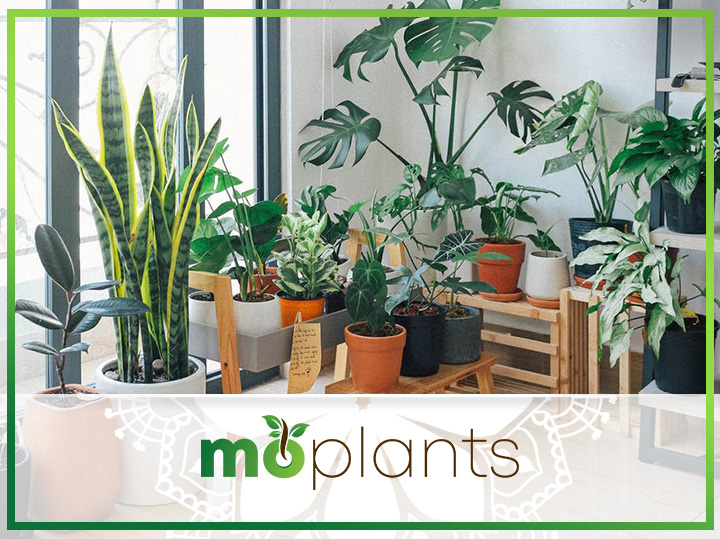Have you ever dedicated weeks or months looking after a houseplant only for it to wither away unexpectedly? If you are a beginner who has just started dipping your toes in the world of gardening, this experience is likely to dishearten and make you wonder if you did something wrong. You may even find yourself asking, “what do plants need to grow and survive?” as you browse through the seeds and young plants at your nearest garden center.
The truth is that there is no single answer to this fundamental question. Every plant has its unique needs, so what works for one species may not work for another. For example, the growing conditions for a tropical plant vary significantly from those of a succulent. Similarly, a flowering plant may require more nutrients and warmth than most herbs.
Conversely, if you want to turn your home into a tropical haven with luscious foliage climbing on the walls and stunning flowers adding a burst of color to your space, you should make sure to choose appropriate plants and study their individual requirements. In addition, learning about the native habitat of certain species can be rather beneficial for those looking to grow plants indoors.
Since growing plants requires a fair amount of time and hard work, we have put together a guide on all the things plants need to grow and thrive in an average home environment.
What Do Plants Need to Grow and Survive?
Here are the four main things plants need to grow and survive.
Water
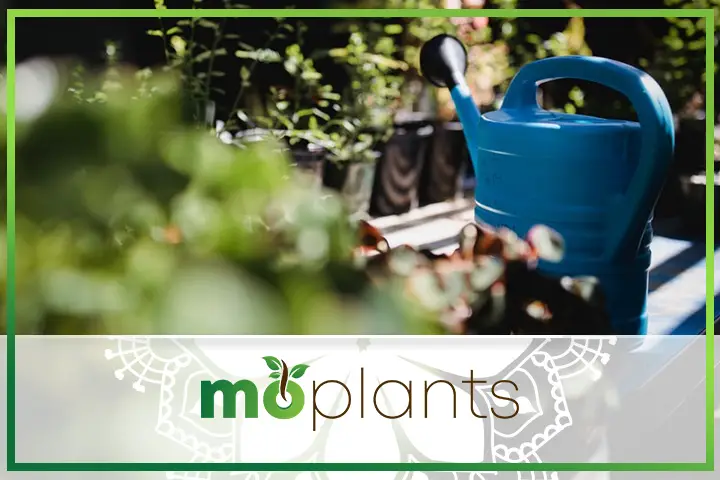
We all know that plants need water to survive. But did you know that they are actually made up of about 90% water?
Unlike humans and animals, most plants don’t store water. Instead, they use the fluid to transport nutrients from roots to the stem, branches, and leaves. The thin root hairs absorb the moisture from the soil, enabling it to travel all the way to the foliage. Once it reaches the leaves, it evaporates through stomata. This process is extremely crucial to the survival of a plant. In addition, it enables the plant to absorb carbon dioxide and produce oxygen during the daytime.
It should not come as a surprise that almost every plant has different watering needs. While some prefer frequent watering and slightly moist soil, others flourish when their potting medium completely dries out between each watering session. Similarly, some plants are rather forgiving of neglect and would survive for weeks without water, whereas others would begin to droop even if you forget to water them once.
It is also important to note that plants typically require more water during the summer months than in the winter. Moreover, indoor plants are more likely to be overwatered than the ones planted outdoors. Nonetheless, both underwatering and overwatering can ultimately kill your plant.
Some of the most common symptoms of underwatering include brown leaves, dry edges, and stunted growth. If not treated with care, the plant eventually begins to shed the foliage and dies. On the other hand, overwatered plants usually suffer from root rot and consequently develop an unpleasant smell or fungal growth.
If you are having difficulty figuring out how often to water your plants, consider touching their potting medium to determine if it feels dry or moist. If the top two inches of the soil feel wet, you should ideally hold off on watering. However, if the soil is completely dry, you can thoroughly water the plant and discard the excess fluid accumulated in the saucer placed underneath the pot.
Water also plays a crucial role in photosynthesis, which takes us to our next point.
Sunlight
Plants cannot grow and survive without some form of light. If you are growing plants indoors, you can consider replacing natural light with an artificial one.
Light is vital for photosynthesis, during which the plant captures photons from the light source and uses them to convert water and carbon dioxide into carbohydrates and oxygen. While the former provides the plant with sustenance, the latter is released into the environment.
Different plants have different light preferences. For instance, tomato and cucumber plants require full sun to grow, whereas aloe vera and most other succulents only need about six hours of bright but indirect light to thrive. On the other hand, rhododendrons do well in the dappled shade, while begonias prefer partial or filtered light.
Several plants can survive in relatively dark corners of your house, but even they need light to grow. Snake plants, dumb cane, and Chinese evergreen are great examples of this. Although these plants can easily grow in almost every part of your home, they require a certain amount of artificial or filtered light to continue their photosynthesis process.
The lack of light usually causes plants to become leggy. They also begin to lose their color and eventually die. Meanwhile, exposing them to too much light can result in burnt and crispy foliage. Therefore, make sure to monitor your houseplant carefully to determine how much sunlight it may need.
Furthermore, don’t forget to rotate your plant every couple of weeks for symmetrical growth. Since the foliage tends to grow in the direction of the sun, turning the pots allows all leaves to receive an equal amount of light.
Air
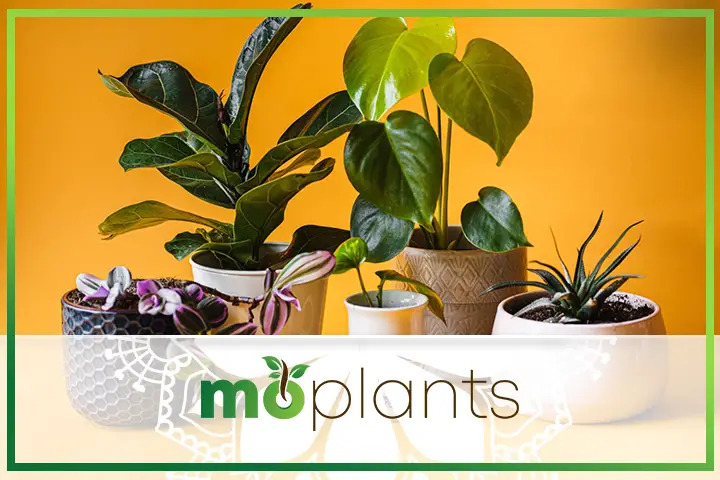
There are two primary reasons plants need air to grow: photosynthesis and breathing.
Plants absorb carbon dioxide from their surroundings and turn it into oxygen, which is the opposite of what humans do to convert food into energy. It is also worth mentioning that plants require air both above and under the ground.
Since air above the ground is often taken for granted, most people fail to notice the effects of pollution on their houseplants. Though they are considered natural air purifiers, plants also need somewhat fresh air to stay alive. Hence, if the air inside your home is filled with toxins and pollutants, it may affect the growth and appearance of the foliage.
Similarly, the roots also require air to breathe. If the soil is waterlogged or the potting medium is densely packed, the roots will not be able to absorb moisture and nutrients, resulting in a wilted plant. If this goes on for quite some time, the leaves will turn yellow or brown, and the plant will eventually die.
Therefore, loosely packed soil with sufficient air pockets and adequate watering is essential for plants to grow and survive. Most experts recommend placing your potted plants near open windows and doors where they can have access to fresh air. However, f you have placed your houseplant in your bedroom to add a pop of color to your décor, please make sure to keep the area well ventilated so that your plant is not exposed to a high level of Volatile Organic Compounds in the air.
Most tropical plants can survive outdoors during the growing season, as long as you provide them with partial shade. However, don’t forget to bring your plants indoors once the temperature begins to drop, as most of them are not tolerant of frost and cold drafts.
Nutrients
There are six nutrients that all plants need to remain healthy: nitrogen, potassium, phosphorous, magnesium, calcium, and sulfur. Here is what you should know about each of them.
Nitrogen: It helps plants produce chlorophyll, which gives the foliage its green color and assists in photosynthesis. A lack of nitrogen usually results in discolored or pale leaves, so please make sure to buy soil that is rich in organic matter.
You can also invest in liquid fertilizers or fertilizers pellets to ensure your plant receives a sufficient amount of nitrogen throughout the growing season.
Potassium: This nutrient plays an important role in strengthening the roots of a plant and helping it retain water. More importantly, it supports the immune system of these green beauties and helps them fight off any diseases or pests that may endanger their survival.
Phosphorus: It is an essential nutrient that helps plants bloom. It also enhances root growth and enables plants to withstand harsh temperatures and other environmental stressors.
Magnesium: Considered a micronutrient, magnesium works with nitrogen to maintain the green color of the plant. Hence, if the foliage of your favorite houseplant appears a little pale, you may want to consider buying a fertilizer that is rich in magnesium.
Calcium: Plants typically get calcium through the water. The mineral aids in the growth and development of the cells walls, thus strengthening the plant tissue. Yellowing and wilting leaves are among the common signs of calcium deficit in mature plants.
Sulfur: Last but not least, sulfur enables plants to ward off diseases and pest infestations. It also contributes towards the production of amino acids and enzymes, enabling healthy plant growth.
Infographic
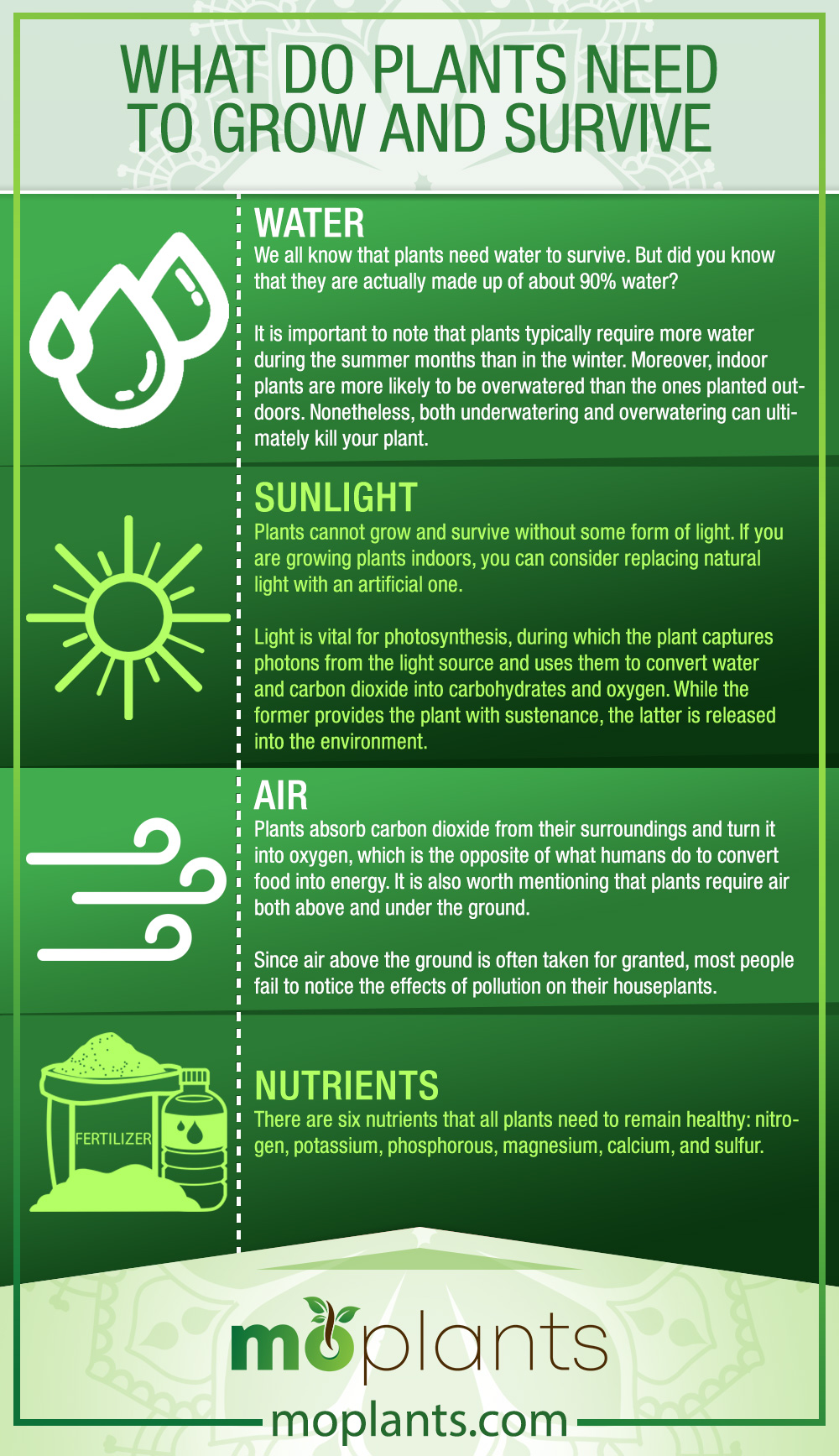
Additional Things Plants Need to Grow
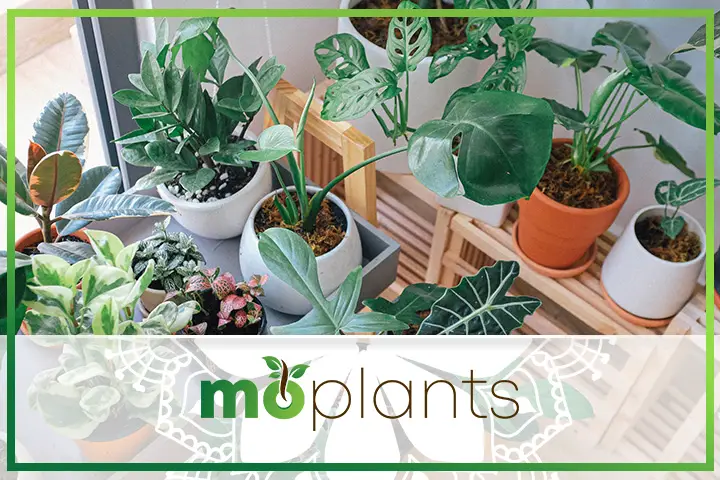
Now that we know what do plants need to grow and survive, here are some additional requirements you should know about.
Space
All plants need some room to grow.
As your outdoor and indoor plants grow taller, their roots also become longer and thicker. Therefore, most experts recommend repotting the plant by moving it to a bigger container every year or so. Failure to do so may cause your plant to become rootbound, which would stunt its growth and increase the risk of diseases.
Temperature
When it comes to growing plants indoors, most species do well in temperatures between 65 and 80 degrees Fahrenheit during the day and 55 to 64 degrees Fahrenheit at night.
While some plants may require a warmer temperature to grow, others may flourish in slightly lower temperatures. Nevertheless, please make sure to keep your plants away from heat vents and air conditioners, as extreme temperature changes can be detrimental to their survival.
Humidity
Finding out the right humidity level for indoor plants can be a slippery slope.
Typically, tropical plants do well in humidity levels between 40 and 60%. If you live in a particularly dry climate, you may want to invest in a humidifier for your precious plants. Alternatively, you can provide them with artificial humidity by placing the container on a tray filled with pebbles and water. Please make sure the bottom of the potted plant does not touch the water and rests on top of dry pebbles. As the moisture evaporates, it will coat the leaves of the plant in a thin layer of dew that will help keep them fresh and healthy.
Meanwhile, succulents prefer relatively low humidity, as too much moisture in the air can result in fungal infections and pest infestations.
Pruning
All home gardeners must use clean and sterilized pruning shears to remove a few branches, leaves, or offshoots of their plants every few months. This practice encourages new growth, deters pest infestations, and prevents the plant from becoming lopsided.
Most plants prefer to be pruned during their dormant season, while some must only be pruned during the growing season.
Cleaning
The layer of dust on the vibrant foliage of your plants can be detrimental to their growth. It can hinder the ability of your plant to photosynthesize, thus exposing it to a series of problems. Moreover, plants covered in dirt and debris are more likely to be targeted by spider mites, mealy bugs, aphids, scales, grasshoppers, and other notorious insects.
Therefore, please make sure to mist your plants every few weeks and gently wipe the leaves with a soft cloth. Doing so will not only keep them healthy for a long time but also add to their aesthetic appeal.
Infographic
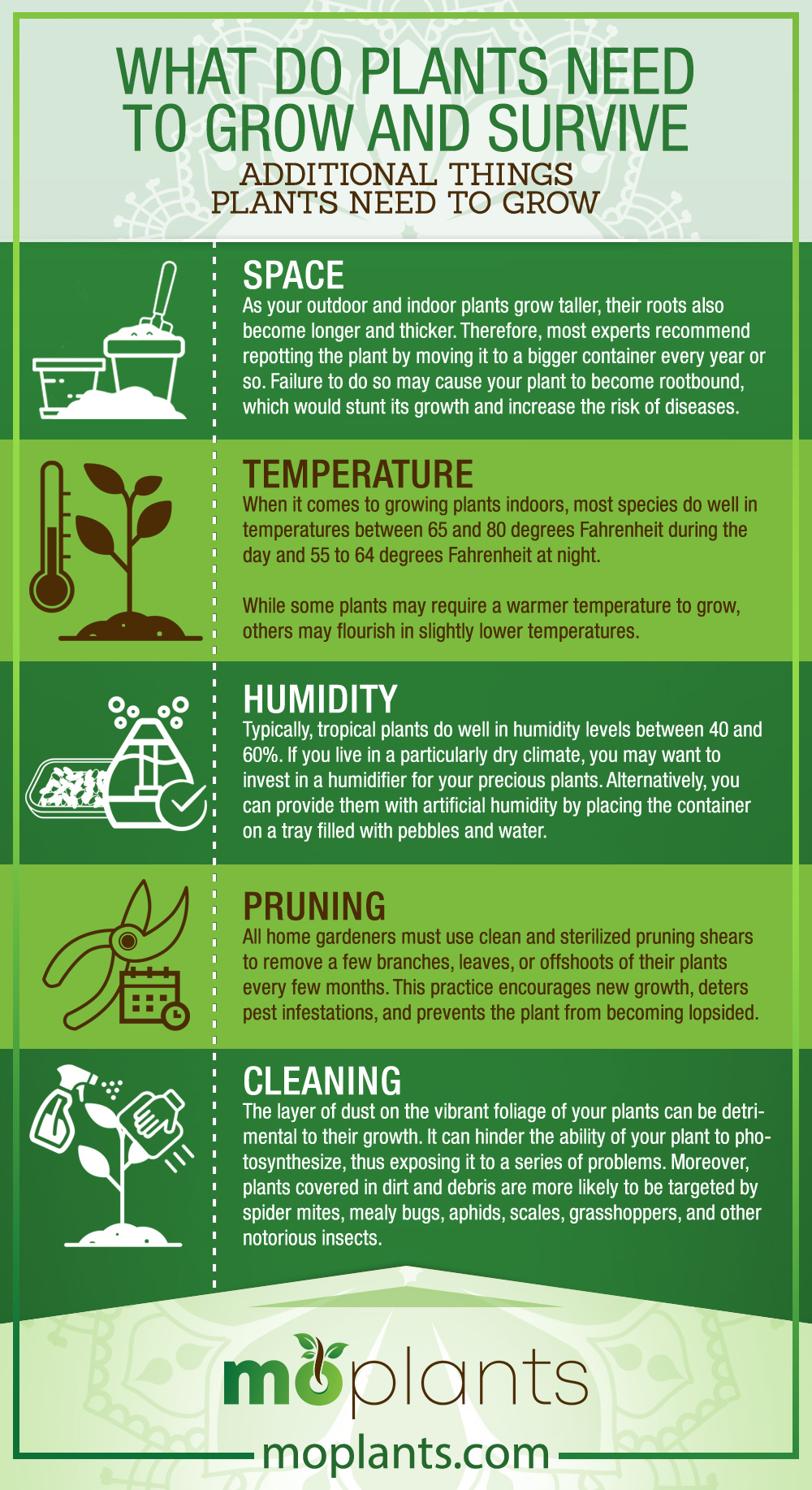
Frequently Asked Questions

Here are some of the most frequently asked questions about what do plants need to grow and survive.
What do plants need to grow?
Plants need air, light, water, and nutrients to stay healthy.
Why do plants need light?
All plants need light for photosynthesis. If you are growing plants indoors, please make sure to keep them in a place that receives adequate bright and filtered light.
Why do plants need water?
Water helps the plant transport nutrients from the soil to the leaves while also assisting with photosynthesis.
On a Final Note
All plants need light, water, air, and nutrients to grow and thrive. If you fail to provide your houseplants with any of these essentials, they will begin to show signs of distress and eventually die.
However, as mentioned above, each species of plant is different from another. So, before you buy a pretty-looking plant from a nearby nursery to add some depth and color to your home, please determine if it will be able to acclimate to your home environment.

